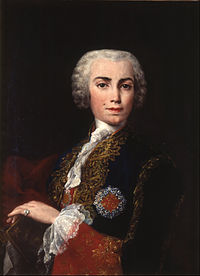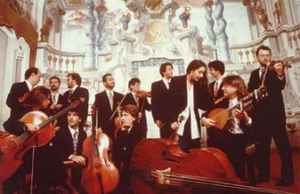FARINELLI (Cecilia Bartoli)
Farinelli is an album made by Cecilia Bartoli, Il giardino armónico and the conductor Giovanni Antonini. The album was published on November 29, 2019, by Decca Classics. It is a tribute to Carlo Maria Michelangelo Nicola Broschi, presenting works by composers Porpora, Broschi, Giacomelli, Caldara, Hasse.
Farinelli is about the transformation artists experience on stage. Through the music written and performed by Farinelli, Cecilia Bartoli tried to show how the amazing qualities of her voice and her profound musical mastery allowed the castrato to play characters with stereotypes of women and men.

History
Carlo Maria Michelangelo Nicola Broschi [1] (Andria, January 24, 1705-Bologna,

Farinelli left for Spain in 1737, where he lived for almost 25 years. His voice was used to cure King Philip V, the first Bourbon, of his melancholic depression. This had not only end up giving him power, but also the official name of prime minister. For two decades, night after night, he was asked to sing the same arias to the king. He was given the rank of knight in 1750 and was decorated with the Cruz de Calatrava. He used his power at court to persuade Ferdinand VI to establish Italian opera. He also directed the Royal College of Santa Bárbara for Children Musicians, popularly known as “Casa de los Capones”. After the accession of Carlos III, Farinelli retired in 1760 to Bologna until his death.
Cecilia Bartoli (July 4, 1966 in Rome, Italy). Mezzo-soprano, daughter of singers. She studied singing at the Santa Cecilia Conservatory in Rome. She made her debut at the age of 20 in that same city with El Barbero de Sevilla. In addition to becoming a famous bel canto singer, she has also dedicated several of her albums to ancient arias and baroque repertoire. Some of her albums are: Arie Antiche: Se tu m’ami’, Mozart Arias, Chant D’Amour’ ‘Sacrificium’, Farinelli.

Today, the singer is an artistic director of the Salzburg Easter Festival. Bartoli has also been appointed as the artistic director of the Opéra de Monte-Carlo from 2023.
As a light coloratura mezzo-soprano, she has a velvety timbre and an elaborate technique. Bartolli has a very versatile way of singing, she has great agility, an extensive vocal range and strength at the same time that he can transport us towards delicacy and powerful sensitivity.
She accumulates a large shelf of awards and distinctions such as the Grammy received in 2008 for his album Sacrificium, where he already shows his great interest and appreciation for the castrati.
Il Giardino Armonico [2] is an Italian chamber music ensemble that performs baroque music, founded in Milan, Italy, in 1985 by Giovanni Antonini (current director) and Luca Pianca. Most of Il Giardino Armonico’s repertoire is made up of pieces from the 17th and 18th centuries.
The group has performed in some of the most important concert halls and festivals in the

They have received several awards such as the Gramophone Award (in 1996, for Vivaldi’s Il Proteo) and the Grammy (in 1999 for the Vivaldi Album). This group performs both in concerts and in operatic productions by composers such as Claudio Monteverdi, Haendel and Pergolesi.
Farinelli
The Farinelli album recreates, in part, the repertoire that Carlo Maria Michelangelo Nicola Broschi performed. Thus, we find 11 works: [3]
Nell’attendere Mio Bene – Nicola Porpora (5:11)
Vaghi Amori, Grazie Amate – Nicola Porpora (9:20)
Morte Col Fiero Aspetto – Johann Adolf Hasse (3:37)
Lontan Dal Solo E Caro… Lusingato Dalla Speme – Nicola Porpora (8:17)
Chi Non Sente Al Mio Dolore – Riccardo Broschi (8:00)
Come Nave In Ria Tempesta – Nicola Porpora (5:03)
Mancare o Dio mi sento – Geminiano Giacomelli (9:36)
Si, Traditor Tu Sei – Riccardo Broschi (6:03)
Questi al cor finora ignoti – Antonio Caldara (5:03)
Signor, la Tua Speranza… A Dio Trono, Impero A Dio – Johann Adolf Hasse (5:53)
Polifemo - Alto Giove – Nicola Porpora (9:22)
‘’My new album is dedicated to – and named after – the celebrated singer. But I am not speaking about the man, born Carlo Maria Michelangelo Nicola Broschi in Andria, Italy, in January 1705. Nor is the album about current sociopolitical topics, such as issues of gender identity, or about anatomy. It is about art and music. More precisely, Farinelli is about the transformation artists undergo on stage. Through music written for – and performed by – Farinelli, I am trying to show how the astounding qualities of his voice and his profound musicianship allowed him to transmit the Egyptian queen Cleopatra’s sensuality as convincingly as the virility of heroic warriors from mythical times.’’ - Cecilia Bartoli
In the two opening tracks, Bartoli plays two young men - Aci, from the opera Polifemo, and Imeneo from La festa d’Imeneo (both by Porpora). In the first piece, she drives the music forward with exaggerated consonants, a clean ‘’marcato-agitato’’ style and expert melismas. She sacrifices the purity of her tone for the expression that the aria needs, moving to a rather wide vibrato and pure chest, in order to gain emotiional power. In the second piece, she chose a quiet Cecilia - that never overstates the text, singing straight and quietly to create a sense of confidence and intimacy. The Giardino Armonico also changes the character in the Aci’s bluster, which are full and heavy, while under Imeneo are delicate and light.
In the third and tenth tracks, Bartoli transforms into a defiant Cleopatra. This is the only woman Bartoli gets to play on the album. This was one of the characters for which Farinelli became a recognized figure. She makes a fiery and determined Cleopatra - as the musical lines rise chromatically, she tricks you into thinking she might lose control, just as Cleopatra seems to be losing control of her own fate. Bartoli never does come entirely unhinged, though, and that’s the magic. In the ninth track, Bartoli is a confused and conflicted Abel, and suddenly her voice is almost boyish and innocent. She narrows and purifies her tone, and sings the aria’s melodic leaps with deceptive nonchalance (“non intendo”).
In general, this album is a test of technical control, theory and expressiveness, and also of affection for the style of the castrati.